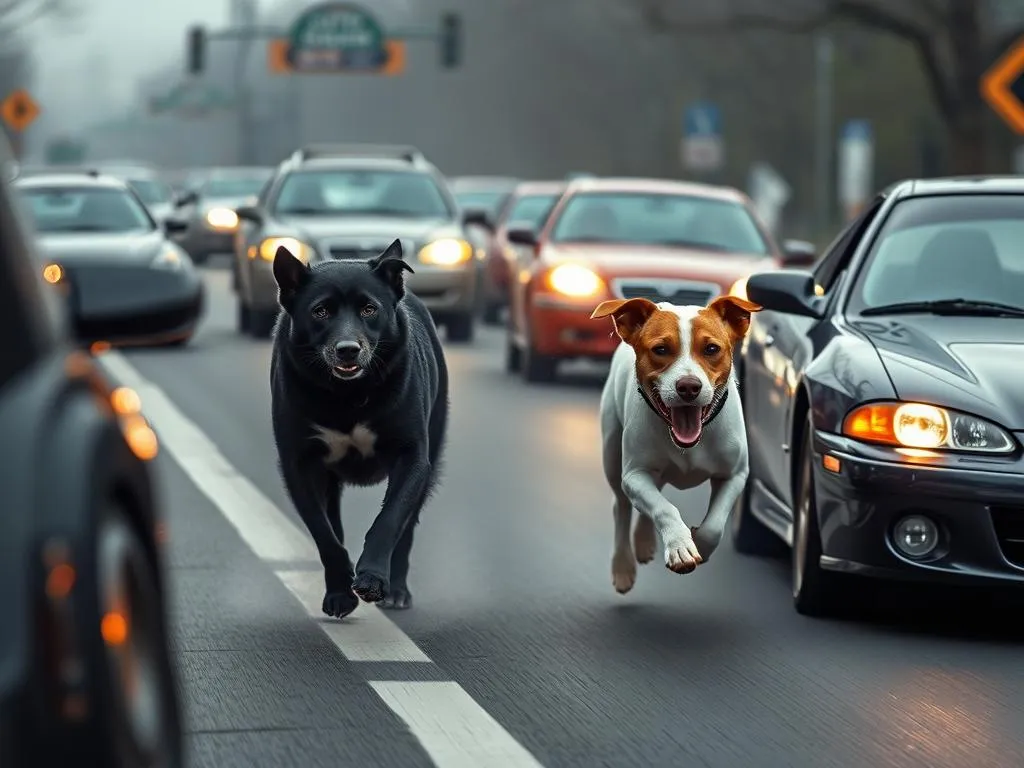
Introduction
Have you ever seen a dog darting down the street in hot pursuit of a passing car? This curious and often alarming behavior is not uncommon, but understanding why dogs chase cars is essential for any pet owner. Recognizing the motivations behind this instinct can significantly impact your dog’s safety, effective training strategies, and your overall awareness as a responsible pet owner. In this article, we will explore the various reasons dogs chase vehicles, the risks associated with this behavior, and practical solutions to help manage and prevent it.
Understanding Dog Behavior
The Instinctual Nature of Dogs
To understand why dogs chase cars, we must first delve into the instinctual nature of dogs. Descendants of wolves, dogs have inherited a variety of behaviors that are rooted in their evolutionary past. As hunters, their survival depended on their ability to chase and capture prey. This predatory instinct is still present in many breeds today, manifesting in various ways, including chasing moving objects like cars.
Instinctual behaviors are not just random; they serve specific functions. For example, when a dog sees a moving object, its instinctual drive kicks in. This reaction is part of their genetic makeup, and it can often lead to behaviors that may seem puzzling to us as dog owners.
Common Canine Behaviors
Dogs exhibit a wide range of behaviors, from barking and digging to chasing and retrieving. Chasing is a natural response to stimuli, particularly when it involves fast-moving objects. For many dogs, the thrill of the chase provides excitement, and the adrenaline rush can be exhilarating. Understanding that this behavior is deeply rooted in their instincts helps in addressing it effectively.
Reasons Why Dogs Chase Cars
Predatory Instincts
One of the primary reasons why dogs chase cars is their predatory instincts. Dogs are hardwired to respond to fast-moving objects, interpreting them as potential prey. This instinct is particularly strong in certain breeds, such as Greyhounds, Border Collies, and Jack Russell Terriers, all of which were bred for their chasing abilities.
When a dog sees a car zooming by, its instinctual response is to give chase. This behavior can be especially pronounced in younger dogs or those who have not been adequately trained or exercised. Understanding this instinctual drive is crucial for owners who wish to curb this behavior.
Fear and Anxiety
Another reason why dogs chase cars is rooted in fear and anxiety. Some dogs may chase vehicles as a reaction to fear or a stressful environment. If a dog feels threatened or anxious, it may run after a car as a way to cope with its fear.
Signs of anxiety in dogs can include excessive barking, trembling, or trying to hide. Addressing these underlying fears through training and desensitization can be key in reducing the likelihood of car chasing behavior.
Boredom and Lack of Exercise
Boredom is another significant factor contributing to the behavior of why dogs chase cars. Dogs that do not receive sufficient physical and mental stimulation may seek out alternative outlets for their energy. Chasing cars can become a thrilling activity that alleviates their boredom, albeit a dangerous one.
To combat this, it’s essential to provide your dog with regular exercise and engaging activities. Incorporating daily walks, playtime, and mental challenges can significantly reduce the likelihood of your dog engaging in car chasing due to boredom.
Attention-Seeking Behavior
Dogs are social animals that thrive on interaction with their owners. Some dogs may chase cars as a means of seeking attention. If a dog realizes that chasing a car results in excitement or a reaction from their owner, they may continue to engage in this behavior.
Understanding the role of reinforcement in this behavior is crucial. If your dog receives attention—positive or negative—when chasing cars, they may be encouraged to repeat the behavior.
The Risks of Chasing Cars
Dangers to the Dog
The dangers of dogs chasing cars cannot be overstated. The most obvious risk is the potential for injury or even death due to car collisions. A dog that runs into the street can be struck by a vehicle, resulting in severe injuries or fatal outcomes.
Moreover, a dog that escapes while chasing a car may get lost or injured in other ways, such as running into traffic or becoming disoriented. The risks extend beyond the dog, as their unpredictable behavior can also lead to accidents involving other vehicles.
Legal and Social Implications
In addition to the physical dangers, there are legal and social implications associated with dogs chasing cars. Many local laws require dogs to be leashed or confined to secure areas, and failing to control your dog can result in fines or other legal repercussions.
Beyond legalities, a dog that frequently chases cars can create tension with neighbors and disrupt the community. Responsible pet ownership necessitates understanding these implications and proactively managing your dog’s behavior to maintain good relationships with those around you.
How to Address the Behavior
Training Techniques
Addressing the issue of why dogs chase cars begins with effective training techniques. Positive reinforcement is one of the most effective methods for redirecting this behavior. Instead of scolding your dog when they chase, reward them for focusing on you or engaging in alternative behaviors.
Teaching commands such as “leave it” or “come” can also help regain control over your dog in situations where they might be tempted to chase. Consistency is key—ensure that all family members are on the same page regarding training practices to reinforce the desired behavior.
Providing Adequate Exercise
Regular physical activity is crucial for reducing the likelihood of dogs chasing cars. A well-exercised dog is less likely to engage in destructive or dangerous behaviors. Aim for at least 30-60 minutes of exercise each day, depending on your dog’s breed, age, and energy level.
Incorporate a variety of activities, such as walks, fetch, and agility training, to keep your dog engaged and stimulated. Not only will this help reduce car chasing behavior, but it will also promote overall health and well-being.
Creating a Safe Environment
Creating a safe environment for your dog is vital in preventing car chasing. Ensure your yard is securely fenced, and consider using barriers to block access to any areas near the road.
When walking your dog, use a sturdy leash and harness to maintain control. Training your dog to walk calmly beside you can also reduce the urge to chase after moving vehicles.
Consulting Professionals
If your dog’s car chasing behavior is persistent and difficult to manage, it may be time to seek help from a professional dog trainer or behaviorist. These experts can provide tailored strategies and training plans suited to your dog’s individual needs.
Look for professionals with good reviews and qualifications in dog behavior management. Consulting with a professional can be an invaluable investment in your dog’s safety and your peace of mind.
Preventive Measures
Early Socialization and Training
Preventing why dogs chase cars starts with early socialization and training. Introducing your puppy to various environments, sounds, and experiences can help them become well-adjusted adults.
Socialization techniques, such as exposing your puppy to different types of vehicles and people, can help minimize the likelihood of chasing behavior later in life. Starting training early gives your dog the foundation they need to understand appropriate behaviors.
Understanding Triggers
Identifying specific triggers that cause your dog to chase cars can help in managing and preventing the behavior. Pay attention to the situations that provoke this response, such as specific types of vehicles or times of day.
Once you understand the triggers, you can implement strategies to manage them. For instance, if your dog is triggered by loud noises, consider desensitization techniques or creating a calm space for them during stressful situations.
Conclusion
Understanding why dogs chase cars is critical for responsible pet ownership. By recognizing the instinctual, emotional, and behavioral factors that contribute to this behavior, owners can take proactive steps to manage and prevent it.
From training techniques to providing adequate exercise and creating a safe environment, there are numerous strategies to help ensure your dog remains safe and well-behaved. Always remember that patience and consistency are essential in addressing any behavioral issue.
By implementing the insights shared in this article, you can help your dog enjoy a fulfilling, safe life while minimizing the risks associated with chasing cars. Responsible pet ownership is not only about love and companionship but also about understanding and managing behaviors for the well-being of your furry friend.









